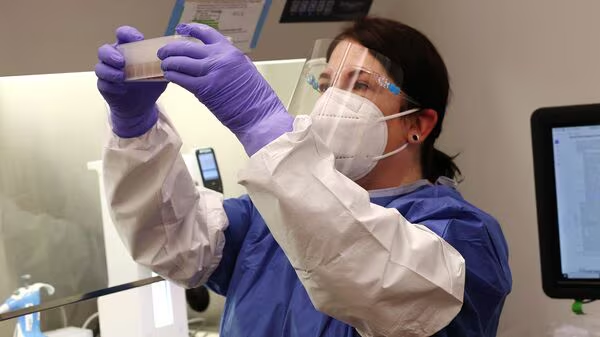
Virus
Rising Cases of Human Metapneumovirus (HMPV) in India: What You Need to Know
Human Metapneumovirus (HMPV) is an emerging viral pathogen causing concern globally and now gaining attention in India due to a recent spike in reported cases. Discovered in 2001, HMPV primarily affects the respiratory system, particularly in children, older adults, and individuals with weakened immune systems. In this article, we delve into the recent surge of HMPV cases in India, its symptoms, transmission, and preventive measures.
What is Human Metapneumovirus (HMPV)?
HMPV belongs to the Pneumoviridae family, similar to Respiratory Syncytial Virus (RSV). It is a non-segmented, negative-sense RNA virus, primarily associated with respiratory tract infections. While most infections are mild, severe cases can lead to complications like pneumonia and bronchiolitis.
Recent Trends in India
In recent months, India has witnessed an unusual uptick in HMPV cases, with outbreaks reported in urban and semi-urban areas. Hospitals have seen a rise in patients presenting symptoms akin to influenza or COVID-19, such as fever, cough, and shortness of breath. Upon testing, a notable percentage of these cases have been attributed to HMPV.
Experts suggest that the increase in cases may be linked to factors such as seasonal changes, decreased immunity due to prolonged pandemic-related restrictions, and increased viral surveillance.
Symptoms of HMPV
HMPV infections range from mild to severe and can mimic other respiratory illnesses. Common symptoms include:
- Fever
- Cough
- Nasal congestion
- Sore throat
- Shortness of breath
- Wheezing
- Fatigue
In severe cases, particularly in infants, elderly individuals, and immunocompromised patients, HMPV can lead to pneumonia or acute bronchiolitis, requiring hospitalization.
Modes of Transmission
HMPV is highly contagious and spreads through:
- Respiratory Droplets: Inhalation of droplets released when an infected person coughs or sneezes.
- Direct Contact: Touching contaminated surfaces and then touching the mouth, nose, or eyes.
- Close Contact: Interactions with infected individuals, especially in crowded settings such as schools, offices, or public transport.

Diagnosis
Diagnosing HMPV requires laboratory tests as its symptoms closely resemble those of other respiratory viruses. Common diagnostic methods include:
- Polymerase Chain Reaction (PCR): Detects the presence of HMPV RNA in respiratory samples.
- Immunofluorescence Assay: Identifies viral antigens in samples.
- Serological Tests: Measures antibodies against HMPV in the blood.
Treatment Options
Currently, there is no specific antiviral treatment for HMPV. Management primarily focuses on supportive care:
- Hydration: Ensuring adequate fluid intake to prevent dehydration.
- Fever Management: Using antipyretics to control fever.
- Oxygen Therapy: Administered in severe cases with breathing difficulties.
- Hospitalization: Required for patients with severe complications such as pneumonia or respiratory failure.
Preventive Measures
Prevention is key to controlling the spread of HMPV. Individuals and communities can take the following measures:
- Personal Hygiene:
- Regular handwashing with soap and water for at least 20 seconds.
- Using alcohol-based hand sanitizers when soap is unavailable.
- Respiratory Etiquette:
- Covering mouth and nose with a tissue or elbow when coughing or sneezing.
- Disposing of used tissues immediately and washing hands.
- Avoiding Crowded Places:
- Limiting exposure to crowded or poorly ventilated areas during outbreaks.
- Disinfection:
- Regularly cleaning frequently touched surfaces such as doorknobs, mobile phones, and countertops.
- Isolation of Infected Individuals:
- Encouraging individuals with symptoms to stay home and avoid contact with others.
Public Health Implications
The sudden rise in HMPV cases highlights the need for heightened surveillance and awareness in India. Public health authorities must:
- Enhance Diagnostic Facilities: Widen access to diagnostic tests for respiratory viruses, including HMPV.
- Promote Awareness Campaigns: Educate the public about HMPV and preventive measures.
- Strengthen Healthcare Infrastructure: Equip hospitals and clinics to manage respiratory infections effectively.
- Encourage Research: Support studies on HMPV’s epidemiology, vaccine development, and treatment options.
Global Context
Globally, HMPV has been recognized as a significant cause of respiratory infections, particularly during the winter and spring seasons. Countries with robust surveillance systems have reported similar outbreaks, often coinciding with other respiratory viruses like influenza and RSV. The rise of HMPV cases in India aligns with this global trend, emphasizing the importance of coordinated efforts to combat such emerging infections.
Conclusion
The increase in Human Metapneumovirus cases in India serves as a wake-up call for the healthcare system to address emerging respiratory pathogens proactively. While HMPV is not as well-known as influenza or COVID-19, its impact on vulnerable populations can be severe. By adopting preventive measures, improving diagnostic capabilities, and raising public awareness, India can mitigate the effects of this virus and safeguard public health.
HMPV Case LIVE: Cases in Gujarat rise to 3 as eight-year-old boy from Sabarkantha found infected

